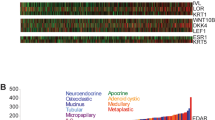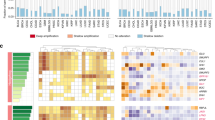Abstract
Activation of the Hedgehog (Hh) signalling pathway by sporadic mutations or in familial conditions such as Gorlin's syndrome is associated with tumorigenesis in skin, the cerebellum and skeletal muscle1,2. Here we show that a wide range of digestive tract tumours, including most of those originating in the oesophagus, stomach, biliary tract and pancreas, but not in the colon, display increased Hh pathway activity, which is suppressible by cyclopamine, a Hh pathway antagonist. Cyclopamine also suppresses cell growth in vitro and causes durable regression of xenograft tumours in vivo. Unlike in Gorlin's syndrome tumours, pathway activity and cell growth in these digestive tract tumours are driven by endogenous expression of Hh ligands, as indicated by the presence of Sonic hedgehog and Indian hedgehog transcripts, by the pathway- and growth-inhibitory activity of a Hh-neutralizing antibody, and by the dramatic growth-stimulatory activity of exogenously added Hh ligand. Our results identify a group of common lethal malignancies in which Hh pathway activity, essential for tumour growth, is activated not by mutation but by ligand expression.
This is a preview of subscription content, access via your institution
Access options
Subscribe to this journal
Receive 51 print issues and online access
$199.00 per year
only $3.90 per issue
Buy this article
- Purchase on Springer Link
- Instant access to full article PDF
Prices may be subject to local taxes which are calculated during checkout




Similar content being viewed by others
References
Bale, A. E. & Yu, K. P. The hedgehog pathway and basal cell carcinomas. Hum. Mol. Genet. 10, 757–762 (2001)
Wechsler-Reya, R. & Scott, M. P. The developmental biology of brain tumors. Annu. Rev. Neurosci. 24, 385–428 (2001)
Taipale, J., Cooper, M. K., Maiti, T. & Beachy, P. A. Patched acts catalytically to suppress the activity of Smoothened. Nature 418, 892–897 (2002)
Taipale, J. & Beachy, P. A. The Hedgehog and Wnt signalling pathways in cancer. Nature 411, 349–354 (2001)
Ingham, P. W. & McMahon, A. P. Hedgehog signaling in animal development: paradigms and principles. Genes Dev. 15, 3059–3087 (2001)
Chen, J. K., Taipale, J., Cooper, M. K. & Beachy, P. A. Inhibition of Hedgehog signaling by direct binding of cyclopamine to Smoothened. Genes Dev. 16, 2743–2748 (2002)
Watkins, D. N. et al. Hedgehog signalling within airway epithelial progenitors and in small-cell lung cancer. Nature 422, 313–317 (2003)
Roberts, D. J., Smith, D. M., Goff, D. J. & Tabin, C. J. Epithelial–mesenchymal signaling during the regionalization of the chick gut. Development 125, 2791–2801 (1998)
van den Brink, G. R. et al. Sonic hedgehog regulates gastric gland morphogenesis in man and mouse. Gastroenterology 121, 317–328 (2001)
Ramalho-Santos, M., Melton, D. A. & McMahon, A. P. Hedgehog signals regulate multiple aspects of gastrointestinal development. Development 127, 2763–2772 (2000)
Hebrok, M. Hedgehog signaling in pancreas development. Mech. Dev. 120, 45–57 (2003)
Bitgood, M. J. & McMahon, A. P. Hedgehog and Bmp genes are coexpressed at many diverse sites of cell–cell interaction in the mouse embryo. Dev. Biol. 172, 126–138 (1995)
Taipale, J. et al. Effects of oncogenic mutations in Smoothened and Patched can be reversed by cyclopamine. Nature 406, 1005–1009 (2000)
Cooper, M. K., Porter, J. A., Young, K. E. & Beachy, P. A. Plant-derived and synthetic teratogens inhibit the ability of target tissues to respond to Sonic hedgehog signaling. Science 280, 1603–1607 (1998)
Berman, D. M. et al. Medulloblastoma growth inhibition by hedgehog pathway blockade. Science 297, 1559–1561 (2002)
Ericson, J., Morton, S., Kawakami, A., Roelink, H. & Jessell, T. M. Two critical periods of Sonic Hedgehog signaling required for the specification of motor neuron identity. Cell 87, 661–673 (1996)
Wang, L. C. et al. Conditional disruption of hedgehog signaling pathway defines its critical role in hair development and regeneration. J. Invest. Dermatol. 114, 901–908 (2000)
Fuse, N. et al. Sonic hedgehog protein signals not as a hydrolytic enzyme but as an apparent ligand for patched. Proc. Natl Acad. Sci. USA 96, 10992–10999 (1999)
Goodrich, L. V., Milenkovic, L., Higgins, K. M. & Scott, M. P. Altered neural cell fates and medulloblastoma in mouse patched mutants. Science 277, 1109–1113 (1997)
Chen, X. & Yang, C. S. Esophageal adenocarcinoma: a review and perspectives on the mechanism of carcinogenesis and chemoprevention. Carcinogenesis 22, 1119–1129 (2001)
Peek, R. M. Jr Helicobacter pylori strain-specific modulation of gastric mucosal cellular turnover: implications for carcinogenesis. J. Gastroenterol. 37 (Suppl. 13), 10–16 (2002)
Lowenfels, A. B. & Maisonneuve, P. Epidemiologic and etiologic factors of pancreatic cancer. Hematol. Oncol. Clin. North Am. 16, 1–16 (2002)
Chen, J. K., Taipale, J., Young, K. E., Maiti, T. & Beachy, P. A. Small molecule modulation of Smoothened activity. Proc. Natl Acad. Sci. USA 99, 14071–14076 (2002)
Acknowledgements
We thank E. Traband and K. Young for technical assistance, E. Montgomery, K. Miyazaki and J. Harmon for cell lines, J. Chen for help with cyclopamine purification and P. Fussell for help with figures. This work was supported by the family of Margaret Lee and grants from the National Institutes of Health (D.M.B., A.M., J.R.E. and P.A.B.). P.A.B. is an investigator and M.R.G. a medical fellow of the Howard Hughes Medical Institute.
Author information
Authors and Affiliations
Corresponding author
Ethics declarations
Competing interests
Under a licensing agreement between Curis, Inc. and the Johns Hopkins University, P. A. Beachy and the University hold equity in Curis and are entitled to a share of royalties from sales of the products described in this article. P. A. Beachy also receives payment and equity for service as a consultant to Curis, Inc. The terms of this arrangement are being managed by the Johns Hopkins University in accordance with its conflict of interest policies.
Supplementary information
Rights and permissions
About this article
Cite this article
Berman, D., Karhadkar, S., Maitra, A. et al. Widespread requirement for Hedgehog ligand stimulation in growth of digestive tract tumours. Nature 425, 846–851 (2003). https://doi.org/10.1038/nature01972
Received:
Accepted:
Published:
Issue Date:
DOI: https://doi.org/10.1038/nature01972
This article is cited by
-
A clinicopathological exploration of Hedgehog signaling: implications in oral carcinogenesis
Journal of Cancer Research and Clinical Oncology (2023)
-
Super-enhancer hijacking drives ectopic expression of hedgehog pathway ligands in meningiomas
Nature Communications (2023)
-
The role of Hedgehog and Notch signaling pathway in cancer
Molecular Biomedicine (2022)
-
The immune microenvironment in gastric adenocarcinoma
Nature Reviews Gastroenterology & Hepatology (2022)
-
Signaling pathways and therapeutic interventions in gastric cancer
Signal Transduction and Targeted Therapy (2022)
Comments
By submitting a comment you agree to abide by our Terms and Community Guidelines. If you find something abusive or that does not comply with our terms or guidelines please flag it as inappropriate.



